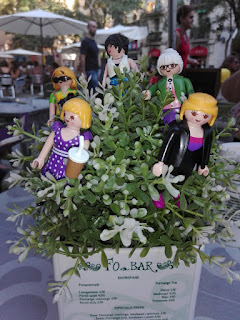 |
| George Orwell |
In a moment of lies, manipulations and false truths is very interesting to reread one of the most brilliant writers and journalists of the last century: George Orwell.
Orwell is the creator of two brilliant works: Homage to Catalonia and Nineteen Eighty-Four.
Orwell is the creator of two brilliant works: Homage to Catalonia and Nineteen Eighty-Four.
Eric Arthur Blair (25 June 1903 – 21 January 1950), better known by his pen name George Orwell, was an English novelist, essayist, journalist, and critic born in Motihari, Bihar, in British India.. His work is marked by lucid prose, awareness of social injustice, opposition to totalitarianism, and outspoken support of democratic socialism.
More information: Brain Pickings
Orwell wrote literary criticism, poetry, fiction, and polemical journalism. He is best known for the allegorical novella Animal Farm (1945) and the dystopian novel Nineteen Eighty-Four (1949).
 |
| Homage to Catalonia Cover |
His non-fiction works, including The Road to Wigan Pier (1937), documenting his experience of working class life in the north of England, and Homage to Catalonia (1938), an account of his experiences in the Spanish Civil War, are widely acclaimed, as are his essays on politics, literature, language, and culture. Orwell's work continues to influence popular and political culture, and the term Orwellian, descriptive of totalitarian or authoritarian social practices, has entered the language together with many of his neologisms, including Big Brother, Thought Police, Room 101, memory hole, newspeak, doublethink, proles, unperson, and thoughtcrime.
Homage to Catalonia is George Orwell's personal account of his experiences and observations in the Spanish Civil War. The first edition was published in the United Kingdom in 1938. The book was not published in the United States until February 1952, when it appeared with an influential preface by Lionel Trilling. The only translation published in Orwell's lifetime was into Italian, in December 1948. A French translation by Yvonne Davet, with whom Orwell corresponded, commenting on her translation and providing explanatory notes, in 1938–1939, was not published until five years after Orwell's death.
Big Brother is a fictional character and symbol in George Orwell's novel Nineteen Eighty-Four. He is ostensibly the leader of Oceania, a totalitarian state wherein the ruling Party wields total power for its own sake over the inhabitants.
 |
| Nineteen Eighty-Four Cover |
In the society that Orwell describes, every citizen is under constant surveillance by the authorities, mainly by telescreens, with the exception of the Proles.
The people are constantly reminded of this by the slogan Big Brother is watching you: a maxim which is ubiquitously on display.
In modern culture the term Big Brother has entered the lexicon as a synonym for abuse of government power, particularly in respect to civil liberties, often specifically related to mass surveillance.
Since the publication of Nineteen Eighty-Four the phrase Big Brother has come into common use to describe any prying or overly-controlling authority figure, and attempts by government to increase surveillance.
Since the publication of Nineteen Eighty-Four the phrase Big Brother has come into common use to describe any prying or overly-controlling authority figure, and attempts by government to increase surveillance.
Early in life I have noticed that no event is ever correctly reported in a newspaper, but in Spain, for the first time, I saw newspaper reports which did not bear any relation to the facts, not even the relationship which is implied in an ordinary lie.
I saw great battles reported where there had been no fighting, and complete silence where hundreds of men had been killed.
I saw troops who had fought bravely denounced as cowards and traitors, and others who had never seen a shot fired hailed as the heroes of imaginary victories; and I saw newspapers in London retailing these lies and eager intellectuals building emotional superstructures over events that had never happened.
I saw, in fact, history being written not in terms of what happened but of what ought to have happened according to various ‘party lines’.
George Orwell
























